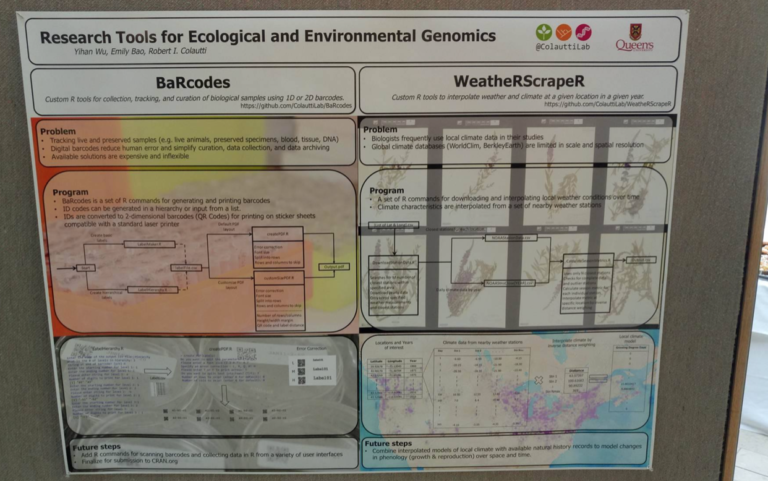
Research Tools for Ecological and Environmental Genomics
Authors: Yihan Wu, Emily Bao, Robert I. Colautti
Queen’s University
Biology Department
Human health and welfare is under threat from anthropogenic climate change, pollution, habitat modification, and the spread of invasive species. These factors contribute to disease and malnutrition, and negatively impact public happiness and quality of life. Our research uses new methods in genomics and bioinformatics to understand and ultimately mitigate the impacts of human activity on global biodiversity and ecosystem services. To facilitate our research, we developed two tools that have broad utility for life scientists.
II-I-II-baRcodes-I-II-III -- Custom R tools for collection, tracking, and curation of biological samples using 1D or 2D barcodes. https://github.com/ColauttiLab/II-I-II-baRcodes-I-II-III
Research across the life sciences often requires the collection, tracking and long-term curation of biological samples. Commercial barcode making tools are available but are often expensive and not easily customized. We wrote a set of open-source tools in R for low-cost management of biological samples. Specifically, our R tools can be used to (i) generate a .csv file containing a set of unique ID codes based on key information provided by the user (e.g. population, individual, collection time); (ii) generate simple 1D or 2D (QR) barcodes for each unique ID; (iii) generate a .pdf file of labels containing 1D or 2D barcode along with human-readable text that can be printed on commercially available vinyl stickers using a standard laser printer. The stickers can then be affixed to biological samples for long-term storage and/or scanned for data collection or tracking using commercially available barcode scanners or smartphones.
WeatheRScrapeR -- Custom R tools to interpolate key weather and climatic conditions at a given location in a given year.
https://github.com/ColauttiLab/WeatheRScrapeR
Global climate databases (e.g. WORLDCLIM, CLIMOND) are excellent tools for broad-scale models involving climate – for example, predicting changes in the distribution of organisms under different climate change scenarios. However, these databases lack fine-scale spatial and temporal resolution necessary for other applications or studies. We wrote WeatheRScrapeR to interpolate local climatic conditions at any location using latitude and longitude in any year, using available weather data from NOAA's National Climatic Data Center (NCDC). As a demonstration, we interpolated climate conditions for herbarium records from across North America to reconstruct evolutionary shifts in flowering time following the introduction of the invasive plant Lythrum salicaria (purple loosestrife) to North America.